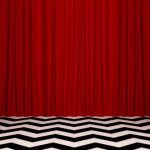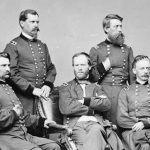 Movies and TV
Movies and TV  Movies and TV
Movies and TV  History
History 10 Things You Didn’t Know About the American National Anthem
 Technology
Technology Top 10 Everyday Tech Buzzwords That Hide a Darker Past
 Humans
Humans 10 Everyday Human Behaviors That Are Actually Survival Instincts
 Animals
Animals 10 Animals That Humiliated and Harmed Historical Leaders
 History
History 10 Most Influential Protests in Modern History
 Creepy
Creepy 10 More Representations of Death from Myth, Legend, and Folktale
 Technology
Technology 10 Scientific Breakthroughs of 2025 That’ll Change Everything
 Our World
Our World 10 Ways Icelandic Culture Makes Other Countries Look Boring
 Misconceptions
Misconceptions 10 Common Misconceptions About the Victorian Era
 Movies and TV
Movies and TV The 10 Coolest Stars to Set Sail on The Love Boat
 History
History 10 Things You Didn’t Know About the American National Anthem
 Technology
Technology Top 10 Everyday Tech Buzzwords That Hide a Darker Past
Who's Behind Listverse?

Jamie Frater
Head Editor
Jamie founded Listverse due to an insatiable desire to share fascinating, obscure, and bizarre facts. He has been a guest speaker on numerous national radio and television stations and is a five time published author.
More About Us Humans
Humans 10 Everyday Human Behaviors That Are Actually Survival Instincts
 Animals
Animals 10 Animals That Humiliated and Harmed Historical Leaders
 History
History 10 Most Influential Protests in Modern History
 Creepy
Creepy 10 More Representations of Death from Myth, Legend, and Folktale
 Technology
Technology 10 Scientific Breakthroughs of 2025 That’ll Change Everything
 Our World
Our World 10 Ways Icelandic Culture Makes Other Countries Look Boring
 Misconceptions
Misconceptions 10 Common Misconceptions About the Victorian Era
10 Times Twin Movies Competed with Each Other
Hollywood is a competitively unoriginal business. Studios constantly recycle the same stories, repackage them as new products, and ponder how to sell them better than their rivals. That pattern inevitably leads to battles at the box office. However, it’s also given way to a strange coincidence.
Sometimes, two studios may release twin movies within the same time frame. These films might boast similar narratives, or they could share a setting. Either way, they target the same market. This unlikely event raises the stakes as the flicks compete for viewers. It turns weekend matinees into close-quarters combat. That outcome may not be the filmmakers’ intent, but that’s how it works out. Seeing which project comes out on top is worth the price of admission.
Related: 10 Movies That Were Meant To Have Sequels But Never Got Them
10 Tombstone & Wyatt Earp
Few Old West figures are more famous than Wyatt Earp. Tombstone (1993) stars Kurt Russell as the gunslinger as he and his brothers serve as lawmen in the Arizona town. They soon run afoul of a cutthroat band, sparking a war that ravages the Earp family and propels the whole region into lawlessness. The tale has been told countless times. In fact, one of those attempts came six months later.
The aptly titled Wyatt Earp (1994) is more of a loving biopic. For one thing, it stars Kevin Costner, who is known for slow, reverent westerns. For another, it goes into greater depth regarding Wyatt’s life. The story covers the hero’s boyhood adventures, his early days working odd jobs, and his turbulent love life. Only after those events does he finally reach Tombstone and kick off the infamous feud with the Cowboys. As you’d expect, this treatment led to a much longer runtime and a less concise pace. That’s partly why it hasn’t resonated with audiences like its rival.[1]
9 Braveheart & Rob Roy
Just as famous as western gunslingers were the Scottish Highlanders. Their struggles against the occupying British forces turned them into folk heroes. A beloved depiction of that conflict was Braveheart (1995). Mel Gibson directs and stars in this biopic about William Wallace. After losing his love and witnessing the tyranny of the foreign oppressors, the highland warrior unites the various clans in a bloody fight for freedom. The film caught some flak for historical inaccuracy, but its rousing emotionality earned it a special place in filmgoers’ hearts. That success, unfortunately, overshadowed another exceptional film.
In contrast, Rob Roy (1995) was a much smaller Highlander tale. Liam Neeson plays the roguish Robert Roy MacGregor. Although he initially tries to do business with the British, his family and friends soon come under threat from a psychotic aristocrat. Not only do these attacks devastate MacGregor and his stalwart sense of honor, but the ensuing violence makes him an outlaw in his own land. His journey felt more personal than Wallace’s, but it had a fraction of the fame.[2]
8 Olympus Has Fallen & White House Down
The Die Hard format has spawned numerous imitations. Olympus Has Fallen (2013) takes that formula to the White House. The popcorn flick features Gerard Butler as a former Secret Service agent. When terrorists storm the capitol and take the president hostage, he must outwit the crooks. The long night sees him eliminate the villains in an increasingly brutal fashion. The resulting film was an entertaining successor to the hard-hitting action flicks of old. The same couldn’t be said of its own successor.
A few months later saw the release of White House Down (2013). This time, Channing Tatum takes the lead as a Secret Service applicant opposite Jamie Foxx as the president. The tale is more of an explosive buddy flick, but it still portrays the White House falling to terrorists. It was also reasonable fun. Sadly, this PG-13 attempt didn’t have the same punch as its R-rated competitor. That’s why Olympus Has Fallen turned into a franchise while White House Down faded into relative obscurity.[3]
7 The Jungle Book & Mowgli: Legend of the Jungle
It’s amazing how the same story can inspire radically different takes. Rudyard Kipling’s The Jungle Book is a testament to that. After initially adapting it in 1966 as a lighthearted cartoon, Disney remade this treasured tale in 2016 as a live-action feature. At its core, it’s about a young boy raised by animals in the wilds of India. That said, the film takes most of its cues from the animation, leading to a whimsical adventure with familiar songs. People ate up that serving of nostalgia despite deviating from the original book.
By contrast, actor/director Andy Serkis gets closer to the source with Mowgli: Legend of the Jungle. Though in production at the same time as Disney’s version, this smaller take didn’t come out until 2018. It also portrays an orphaned child maturing in the jungle, but the tone, themes, and plotting are more in line with Kipling’s vision. Of course, those efforts also made it less digestible to a wider audience, leading to a niche response.[4]
6 Mirror, Mirror & Snow White and the Huntsman
Also an enduring tale, Grimms’ “Snow White” has inspired even more renditions than The Jungle Book. 2012 saw two of them, the first being Mirror, Mirror (2012). It has the familiar framework: Lily Collins as the princess is hunted by Julia Roberts as the evil queen for being the “fairest of them all.” The twist is that it’s an upbeat comedy with flamboyant costumes and dance numbers. The following film couldn’t be more different in that respect.
Snow White and the Huntsman (2012) reinterprets the tale as a dark fantasy spectacle. The film stars Kristen Stewart as a traumatized heroine. Recruiting loyal allies from across the realm, she leads an army against Charlize Theron’s mystical queen. This approach emphasizes perilous action, seeming like a poor man’s Lord of the Rings at points. Neither of these attempts was a classic, but the latter was at least profitable enough to get a sequel.[5]
5 Batman v Superman: Dawn of Justice & Captain America: Civil War
2016 was a year of superhero crossover clashes. The first major brawl occurred at DC with Batman v Superman: Dawn of Justice. Fed up with the Man of Steel’s collateral damage, the Dark Knight wages a one-man war on the alien. Meanwhile, Superman can’t abide Batman’s brutal tactics and strives to shut him down. Their differences escalate to a grudge match spurred on by the villainous Lex Luthor. The scenario was a thinly veiled publicity stunt, one which Marvel pulled shortly after.
Captain America: Civil War fractures the Avengers. After the superheroes’ repeated destruction, the U.S. government proposes they sign over their services and only act under orders. Iron Man supports this oversight, while Captain America rejects it. Not only does this issue divide these two icons, but it splits the Avengers down the middle. Both these flicks suffer from messy plotting and poor characterization, but Civil War at least has more competent structuring and a less pretentious presentation.[6]
4 Evil Dead & Cabin in the Woods
A classic horror setup involves a group of unsuspecting people in a remote cabin. Cabin in the Woods obviously adheres to that foundation. In this 2012 movie, a handful of college kids visit a woodland house for a creepy vacation. Upon staying there, they find themselves the targets of animalistic zombies. It turns out these creatures come from a shadowy organization that engineers the scenario as part of a sick experiment. In that, Cabin in the Woods subverts its own formula. Its competitor, on the other hand, plays it straight.
The Evil Dead helped popularize this premise, so the 2013 remake sticks to it. This flick once again strands a band of buddies in a cabin. One of them finds a hellish book amidst the refuse. Reading its passages brings forth an invasion of demons, who proceed to slaughter the party with sadistic glee. The story doesn’t hold as many surprises as its peer, but the more accomplished filmmaking and terrific presentation perfectly capture the series’ trademark dark humor. It’s possibly for that reason that Evil Dead has enjoyed more enduring love from genre fans.[7]
3 The Great Race & Those Magnificent Men in Their Flying Machines
One of the odder trends in Hollywood focused on globe-trotting races. The film largely responsible was The Great Race (1965). This comedy centers on the dashing Great Leslie and dastardly Professor Fate. To determine who is the best, these rival stuntmen propose a race from New York to Paris. This worldly contest draws drivers from all walks of life, leading to an epic journey of screwball antics. It wasn’t the only one, though.
Just a few days before came Those Magnificent Men in Their Flying Machines (1965). This farcical flick features another worldwide race, this time from London to Paris. Of course, that minor change doesn’t stop the event from attracting drivers of various nationalities. What differentiates the tale is the greater time spent on setup. The actual race doesn’t start until halfway through, making it feel like less of an exciting adventure compared to its competitor. Perhaps that’s why it’s less well-known. Then again, it got a sequel, while The Great Race didn’t. It’s funny how things work out.[8]
2 Antz & A Bug’s Life
In the early days of computer-animated movies, it seemed like anything was possible. Why, then, were two of the biggest examples of the time about bugs? A Bug’s Life (1998) takes place in an ant colony. The timid insects suffer under a roving grasshopper gang, so misfit inventor Flik sets out to find warriors willing to fight the invaders. That proves tricky when the “warriors” turn out to be circus performers. The plot is predictable from there, which isn’t what you’d expect from Pixar’s second feature.
Oddly enough, DreamWorks narrowly beat its rival to the punch with Antz (1998). This story also deals with the little guys subverting the social hierarchy. Granted, the oppressor here is one of their own, but it still falls to an unassuming worker ant conjuring creative solutions to save his colony. Despite that general similarity, Antz uses novel twists for a more mature tone. Which miniature movie was better depended mainly on your preference, as both became mild success stories.[9]
1 Robin Hood & Robin Hood: Prince of Thieves
The Robin Hood legend is an endearing folktale about the common man rising up against his oppressors. Thus, countless adaptations have adapted this familiar story, but two 1991 attempts couldn’t be more different. The first was simply titled Robin Hood, starring Patrick Bergin. This low-budget project is fittingly understated. It frames the iconic narrative within the Saxon-Norman conflict. As a result, it’s more of a historical drama than a high-flying adventure. Audiences wanting the latter had to wait a month.
Soon after came Robin Hood: Prince of Thieves. Despite the odd choice to put Kevin Costner in the title role, this film is a more traditional take. It also has a gritty aesthetic and historical backdrop, but it mixes in the swashbuckling fun that fans know and love, creating an intriguing marriage of old and new. Both takes are adept at what they set out to do, but Prince of Thieves is more widely accessible. That’s probably why it scored a theatrical release while its competition opted for TV.[10]








